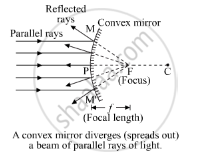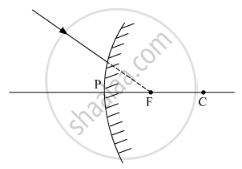Advertisements
Advertisements
Question
Draw diagram to show the action of convex mirror on a beam of parallel light rays. Mark on this diagram principal axis, focus F, centre of curvature C, pole P and focal length f, of the convex mirror.
Solution
Ray Diagram-

APPEARS IN
RELATED QUESTIONS
A mirror forms an image which is 30 cm from an object and twice its height.
(a) Where must the mirror be situated?
(b) What is the radius of curvature?
(c) Is the mirror convex or concave?
Fill in the following blank with a suitable word:
A ray of light which is parallel to the principal axis of a convex mirror, appears to be coming from ............ after reflection from the mirror.
Draw a labelled ray diagram to show the formation of image of an object by a convex mirror. Mark clearly the pole, focus and centre of curvature on the diagram.
The diagrams show the appearance of a fork when placed in front of and close to two mirrors A and B, turn by turn.
Figure
(a) Which mirror is convex
(b) Which mirror is concave
Give reasons for your choice.
An arrow 2.5 cm high is placed at a distance of 25 cm from a diverging mirror of focal length 20 cm. Find the nature, position and size of the image formed.
An object 1 cm tall is placed 30 cm in front of a convex mirror of focal length 20 cm. Find the size and position of the image formed by the convex mirror.
The angle formed between the normal and the refracted ray is known as the angle of incidence.

An object at a distance of +15 cm is slowly moved towards the pole of a convex mirror. The image will get ______.
Assertion: Convex mirrors are used as a rearview mirror in vehicles for observing traffic at our back.
Reason: A convex mirror has a much larger field of view.
